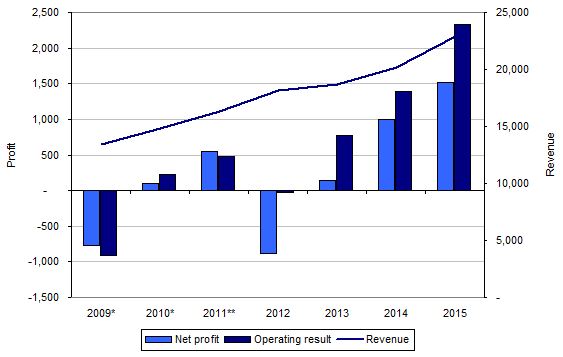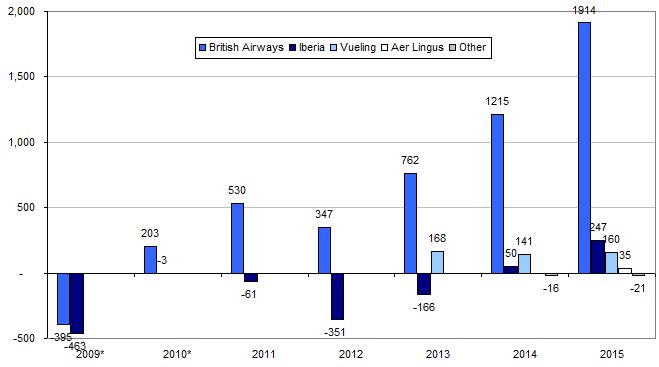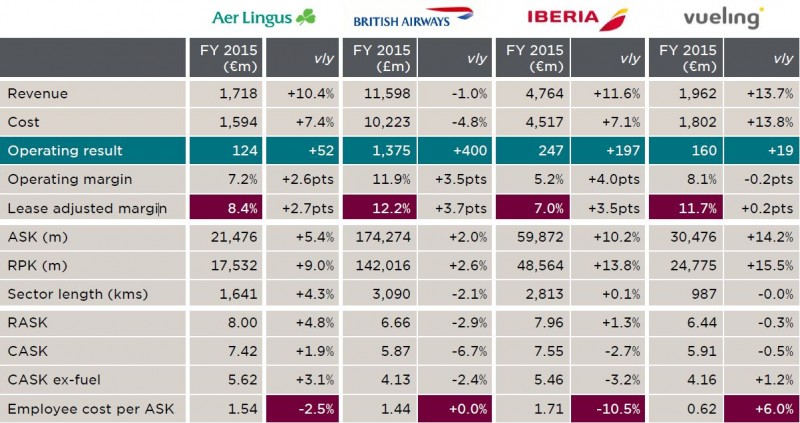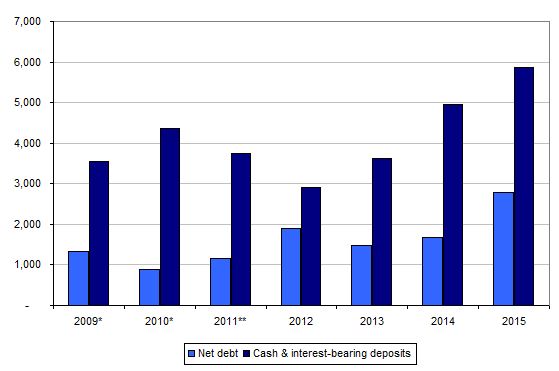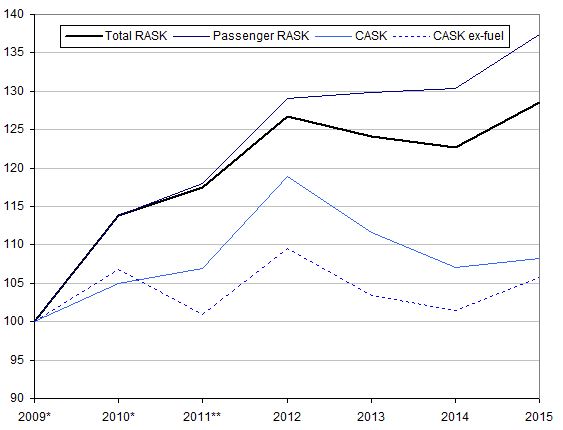IAG has its best ever profit in 2015, helped by fuel and strategic vision and pragmatism
In 2015 IAG achieved a return on invested capital of 12.7% against its estimated cost of capital of 10%, giving it the rare distinction among European legacy airline groups of creating economic value for investors. As with other airlines its 2015 results were helped by lower fuel prices, but IAG's strong improvement owes much to its determination to stick to its goals.
It was the first (arguably the only) airline among the larger European legacy groups to tackle labour cost restructuring. In addition, its 2013 acquisition of Vueling gave it an advantage over Air France-KLM and Lufthansa in dealing with the short/medium haul threat from LCCs. On long haul, it has avoided anti-Gulf airline rhetoric with its Qatar Airways partnership, including codeshare and an equity stake. On the North Atlantic, it is now benefitting from its acquisition of Aer Lingus.
There is more to do. Although Iberia's restructuring has been impressive, its returns still lag those of other IAG airlines. Labour unit costs increased at both British Airways and Vueling in 2015. Moreover, IAG's profitability falls short of its own targets for 2016-2020, and the profitability achieved by the leading European LCCs. Nevertheless, it can be substantially pleased with its progress.
See related reports:
IAG: capital efficiency can help a European legacy airline group to "show me the money"
IAG SWOT: Europe's leading legacy airline group shows financial progress and strategic confidence
IAG's best ever profits came in 2015
IAG's 2015 financial results were its best ever. Net profit increased by 51% to EUR1,516 million, while the pre-exceptional operating result jumped by 68% to EUR2,335 million. Excluding the contribution of Aer Lingus to the group from 18-Aug-2015, the operating result was EUR2,300 million, in line with IAG's guidance range of EUR2.25 billion to EUR2.3 billion.
Revenue grew by 13% to EUR22,858 million, and the operating margin gained 3.3ppts to 10.2%, the first time it has reached double figures. After Icelandair's reported 11.9%, this makes IAG only the second European legacy airline so far to report a double-digit operating margin for 2015, although there are still a number yet to report.
Among the Big Three legacy airline groups in Europe, Air France-KLM achieved a margin of 3.1% and Lufthansa has not yet reported, but consensus forecasts suggest that it is unlikely to reach a double-digit margin (its 2015 annual report is due on 17-Mar-2016). IAG's margin compares favourably with CAPA's estimated average global airline operating margin of 7.2% in 2015 (new high for the world's airline industry).
See related report: CAPA World Airline Profit Outlook 2016: margins at a new high of 8.2%. Fertile ground for new entry
IAG financial highlights 2015
|
EUR million except where stated |
2014 |
2015 |
Change |
|---|---|---|---|
|
Revenue before exceptional item |
20,170 |
22,858 |
13.3% |
|
Operating result before exceptional items |
1,390 |
2,335 |
68.0% |
|
EBIT margin % |
6.9 |
10.2 |
3.3 |
|
Net profit |
1,003 |
1,516 |
51.1% |
|
Cash |
4,944 |
5,856 |
18.4% |
|
Gross debt |
6,617 |
8,630 |
30.4% |
|
Net debt (minus sign indicates net cash) |
1,673 |
2,774 |
65.8% |
|
Net debt incl op leases* |
6,081 |
8,510 |
39.9% |
|
Equity |
3,793 |
5,534 |
45.9% |
|
ASK (millions) |
251,931 |
272,702 |
8.2% |
|
RPK (millions) |
202,562 |
221,996 |
9.6% |
|
CTK (millions) |
5,453 |
5,293 |
-2.9% |
|
Passenger load factor % |
80.4 |
81.4 |
+1.0ppts |
|
Reported |
|
|
|
|
Passenger RASK (c.€) |
7.08 |
7.46 |
5.4% |
|
CASK (c.€) |
7.45 |
7.53 |
1.1% |
|
CASK ex-fuel (c.€) |
5.08 |
5.30 |
4.3% |
Since posting losses in 2012 IAG has grown its net result and operating result every year, with an overall improvement in both of around EUR2.4 billion in three years. In 2011 IAG set a 2015 operating profit target of EUR1.5 billion.
Allowing for the addition to the group of Vueling in 2013, and Aer Lingus in 2015, the like-for-like improvement from 2012 was almost EUR2.2 billion.
IAG revenues, net profit and pre-exceptional operating profit (EUR million) 2009* to 2015
British Airways accounts for 82% of IAG operating profit
By operating airline, the biggest contributor to the group's 2015 operating result was British Airways, with EUR1,914 million, an improvement of 58%. This represented 82% of the group's operating profit. Iberia's operating result was up almost fivefold to EUR247 million, while Vueling's increased by 13% to EUR160 million.
Aer Lingus made a first-time contribution to the group operating result of EUR35 million, for the period from its acquisition by IAG on 18-Aug-2015 to the end of the year. For the full year, Aer Lingus improved its operating profit by 72% to EUR124 million.
IAG operating profit by business segment (EUR million) 2009*-2015
British Airways' 2015 operating margin of 11.9% (up 3.5ppts) was its best ever, beating the 10.0% recorded in the year to Mar-2008, immediately prior to the global financial crisis. Iberia's operating margin of 5.2% (up 4.0ppts) was its best since making 6.7% in 2005.
Aer Lingus' 7.2% margin (up 2.6ppts) was its best for at least a decade. Only Vueling suffered deterioration in its operating margin: a reduction of 0.2ppts to 8.1%. This was its second successive fall in operating margin, but it was still the second best in the group.
See related reports:
British Airways: IAG's favourite child should follow reformed sister Iberia's unit cost example
Iberia: the Futuro looks bright for IAG's star pupil as its confidence and growth are transformed
Vueling's new CEO only needs to stay ahead of rival LCCs on service quality. And keep cutting costs
IAG performance by individual airline brand 2015
Net debt is growing but so is liquidity, and IAG is now paying dividends
IAG's on-balance sheet net debt grew by EUR1.1 billion, or 66%, in 2015 to EUR2.8 billion at year end, largely reflecting the Aer Lingus acquisition and exchange rate movements. Adding capitalised operating leases to this, the adjusted net debt increased by EUR2.4 billion, or 40%, to EUR8.5 billion, due to the operating leases of Aer Lingus and an increase in leased aircraft for BA.
IAG's gross cash position increased by EUR0.9 billion, or 18%, to EUR4.9 billion at the end of 2015. This is equivalent to 94 days of revenues (up from 89 days in at the end of 2014).
As a result of its improved profitability and healthy liquidity, IAG has proposed a final dividend to shareholders of EUR0.10 per share, to be paid in addition to an interim dividend of the same amount already paid. This will bring the total dividend to EUR0.20 per share for 2015, the first year in which IAG has paid dividends.
This puts it among a relatively small, but growing, group of airlines that pay dividends.
IAG development of net debt and cash 2009*-2015
ASKs grew 8.2%, load factor was up 1ppt
IAG increased total ASKs by 8.2% in 2015, with RPKs up 9.6% and passenger load factor up 1.0 ppt to 81.4%, the group's highest ever load factor. Passenger numbers were up 14.2% to 88.3 million. Passenger growth was faster than RPK growth, reflecting the disproportionate increase in short haul traffic, mainly driven by Vueling.
The group's reported growth rates were boosted by the addition of Aer Lingus. On a proforma basis, like-for-like ASK growth was 5.1%, RPK growth was 6.5% and passenger growth 9.3%. British Airways' ASKs increased at the slowest rate, by 2.0%, and its load factor gained 0.5ppts to 81.5%. Iberia's ASKs increased by 10.2%, reflecting a return to long haul expansion in particular, and its load factor gained 2.5ppts to 81.1%.
Vueling's ASK growth of 14.2% was the fastest in the group and its load factor rose by 0.9ppts to 81.3%.
On a full-year basis Aer Lingus increased its ASKs by 5.4%, and its load factor improved by 2.6ppts to 81.6%.
IAG development capacity (ASK, million) and load factor (%) 2010*-2015
IAG ASK growth by region 2015
IAG's revenue rose 13.3%
Total revenue growth of 13.3% was faster than the 8.2% ASK increase and was driven by a 14.2% rise in passenger revenue. The total impact of foreign exchange effects on revenue was a benefit of EUR1,917 million.
Total revenue per ASK grew by 4.6%, boosted by currency movements. At constant exchange rates and excluding Aer Lingus, the underlying RASK performance was reduced by 4.1%. Underlying passenger RASK fell by 3.7%.
All of IAG's airlines contributed to revenue growth, although BA's revenues in GBP actually declined by 1.0%. Due to the strength of GBP versus EUR, this BA revenue performance translated into a 9.7% increase in EUR terms.
IAG said that passenger unit revenue reduction (at constant currency) "follows a pattern of industry growth in a falling fuel cost environment, allowing the airlines to increase margins despite lowering fares". Underlying yields fell at BA and Iberia due to pressure from lower fuel prices, particularly on oil-related routes, and "economic uncertainty" and currency weakening in Latin America, Africa and the Middle East, although "revenue performance still remained strongest in our main key market, North Atlantic".
At Vueling yield pressure weighed less, a reduction of 1.5%, thanks to its relative strength in its domestic market. Aer Lingus yield was up since the acquisition, thanks to strength on the North Atlantic.
IAG consolidated revenues (EUR million) 2014 and 2015
|
|
2014 |
2015 |
Change |
% of 2015 revenue |
|---|---|---|---|---|
|
Passenger revenue |
17,825 |
20,350 |
14.2% |
89.0% |
|
Cargo revenue |
992 |
1,024 |
3.2% |
4.5% |
|
Other revenue |
1,353 |
1,484 |
9.7% |
6.5% |
|
Total |
20,170 |
22,858 |
13.3% |
100.0% |
|
|
|
|
|
|
|
14,456 |
15,862 |
9.7% |
69.4% |
|
|
3,989 |
4,412 |
10.6% |
19.3% |
|
|
1,725 |
1,962 |
13.7% |
8.6% |
|
|
- |
622 |
- |
2.7% |
|
|
Total revenue |
20,170 |
22,858 |
13.3% |
100.0% |
Costs rose 9.3%; but lower fuel prices saved EUR400 million
Total operating costs before exceptional items increased by 9.3%, faster than the increase in ASKs, but slower than growth in revenue. Fuel costs grew by only 1.6%, in spite of the increased capacity. According to CAPA calculations, IAG's fuel bill was almost EUR400 million lower than it would have been at the average fuel cost per ASK that the group paid in 2015.
Non-fuel costs outpaced ASK growth, with an increase of 12.9%. However, costs were adversely affected by foreign exchange effects to the extent of EUR1,828 million (EUR89 million less than the revenue boost from currency movements).
Total cost per ASK grew by 1.1%, inflated by currency movements. At constant exchange rates and excluding Aer Lingus, the underlying CASK performance was lower by 8.2%. Ex fuel unit cost was up 4.3% as reported, but fell by 4.3% excluding Aer Lingus and currency movements (a slightly bigger fall than the underlying fall in RASK).
IAG operating costs 2014 and 2015, EUR million
|
Costs |
2014 |
2015 |
Change |
% of 2015 costs |
|---|---|---|---|---|
|
Employee costs |
4,325 |
4,905 |
13.4% |
23.9% |
|
Fuel |
5,987 |
6,082 |
1.6% |
29.6% |
|
Handling, catering, other operating |
2,063 |
2,371 |
14.9% |
11.6% |
|
Landing fees & en route charges |
1,555 |
1,882 |
21.0% |
9.2% |
|
Engineering |
1,276 |
1,395 |
9.3% |
6.8% |
|
Property, IT & other |
927 |
965 |
4.1% |
4.7% |
|
Selling costs |
859 |
912 |
6.2% |
4.4% |
|
Depreciation, impairment |
1,196 |
1,307 |
9.3% |
6.4% |
|
Aircraft leases |
551 |
659 |
19.6% |
3.2% |
|
Currency differences |
41 |
45 |
9.8% |
0.2% |
|
Total |
18,780 |
20,523 |
9.3% |
100.0% |
|
Total ex fuel |
12,793 |
14,441 |
12.9% |
70.4% |
Labour unit cost increased in 2015, but the longer term trend is reduction
IAG's labour costs grew by 13.4% in 2015, faster than ASK growth and also faster than the 2.3% increase in headcount. The increase in average employee numbers mainly reflected the Aer Lingus acquisition, with headcount reduction at Iberia balancing growth at Vueling.
There was a 10.8% increase in labour cost per employee to EUR80,600. This more than offset the benefit of improved labour productivity, defined as ASK per employee, which rose by 5.8%. The result was that employee costs per ASK grew by 4.8%.
This apparent deterioration in labour cost productivity results is balanced by two offsetting positive factors. Firstly, the strength of GBP and USD inflated IAG's labour costs reported in EUR and, at constant currency, labour cost per ASK fell by 3.5%. Secondly, revenue per employee increased by 10.8% to EUR375,600 and this growth rate matched the increase in labour cost per employee.
Moreover, since the creation of IAG in 2011 productivity measures have improved. From 2011 to 2015 employee cost per ASK fell by 0.9%, thanks to a 19.4% improvement in ASK per employee offsetting an 18.3% increase in average labour cost per employee. Furthermore, revenue per employee has jumped by 30.5% over this period.
IAG labour productivity measures 2011 to 2015
|
|
2011 |
2012 |
2013 |
2014 |
2015 |
Change 2015 vs 2014 |
Change 2015 vs 2011 |
|---|---|---|---|---|---|---|---|
|
Total full time equivalent headcount |
56,791 |
59,574 |
60,089 |
59,484 |
60,862 |
2.3% |
7.2% |
|
Total labour cost EUR million |
3870 |
4341 |
4,123 |
4,325 |
4,905 |
13.4% |
26.7% |
|
Employee cost per employee (EUR) |
68,145 |
72,867 |
68,615 |
72,709 |
80,592 |
10.8% |
18.3% |
|
ASK (million) per employee |
3.75 |
3.68 |
3.84 |
4.24 |
4.48 |
5.8% |
19.4% |
|
Employee cost per ASK (EUR c) |
1.82 |
1.98 |
1.79 |
1.72 |
1.80 |
4.8% |
-0.9% |
|
Revenue per employee |
287,704 |
304,109 |
310,789 |
339,083 |
375,571 |
10.8% |
30.5% |
RASK grew faster than CASK in 2015
For IAG, 2015 was the first year since 2012 that both total RASK and CASK increased. At that earlier time, CASK grew faster than RASK and the group recorded an operating loss (this was compounded by an increase in fuel CASK, but non-fuel CASK also grew).
In 2015, the improved operating result was achieved because RASK growth outpaced CASK growth, even after taking account of lower fuel prices. RASK was up 4.6%, while CASK was up just 1.1% and ex fuel CASK was up 4.3%. As noted above, both RASK and CASK were inflated by currency movements and so - the underlying trend in both was downwards. Nevertheless, the difference between the two was positive for profitability.
Much of IAG's profit improvement in recent years can be attributed to improved efficiency with labour costs. However, BA's employee unit costs rose in 2015 due to salary increases and pension costs, and Vueling's grew as a result of a new crew agreement and increased costs of new bases.
Both BA and Vueling will soon have new CEOs. Alex Cruz will move from Vueling to take over from the retiring Keith Williams as CEO at BA, and he will be replaced at Vueling by Javier Sánchez-Prieto. As CAPA has noted previously, both airlines will need to maintain a strong cost discipline.
See related reports:
British Airways: IAG's favourite child should follow reformed sister Iberia's unit cost example
Vueling's new CEO only needs to stay ahead of rival LCCs on service quality. And keep cutting costs
IAG - index of operating cost per ASK and fare revenues per ASK (each indexed to 100 in 2009)
Medium term goals are in sight
For 2016 IAG expects to increase its operating profit by a similar absolute amount to the improvement achieved in 2015; in other words - an increase of around EUR945 million. This would take the operating profit to almost EUR3.3 billion in 2016.
It also expects its fuel bill to be EUR4.8 billion in 2016 - based on IAG's hedging programme, current fuel prices and exchange rates. According to CAPA calculations, this is around EUR1.7 billion lower than it would be if there was no further change in fuel cost per ASK from 2015 levels.
IAG's profit guidance implies that a significant proportion of expected fuel cost savings will be passed on to passengers as lower unit revenue.
With uncertainties surrounding the world economic outlook, IAG is right to be cautious about unit revenues. Nevertheless, in spite of this, and only partly thanks to lower fuel prices, it is an indication of its strong financial progress that it is now in line to achieve results consistent with its medium-term goals: an operating margin in the range of 12%-15% and a return on invested capital of 15%.
See related report: IAG: capital efficiency can help a European legacy airline group to "show me the money"
